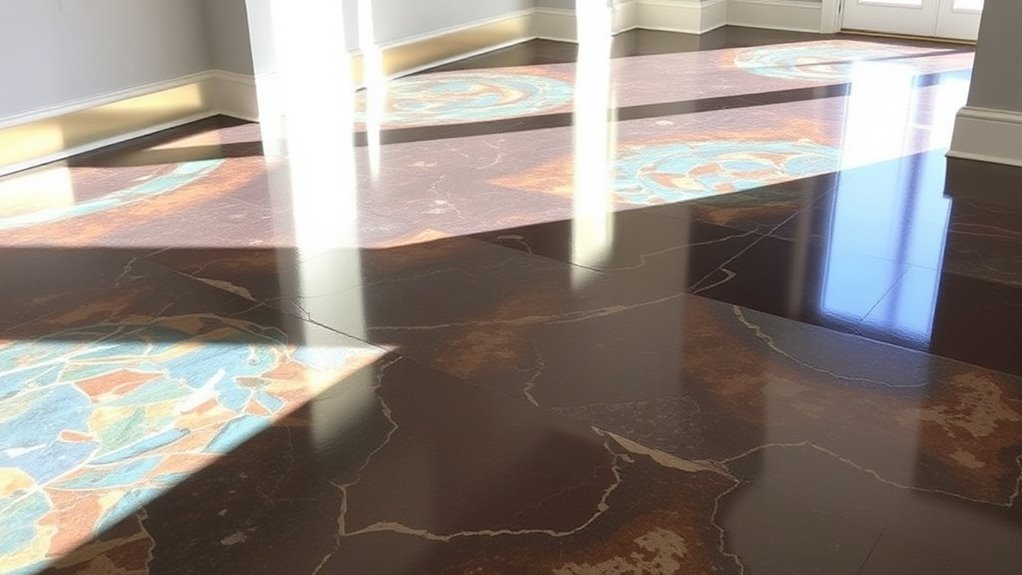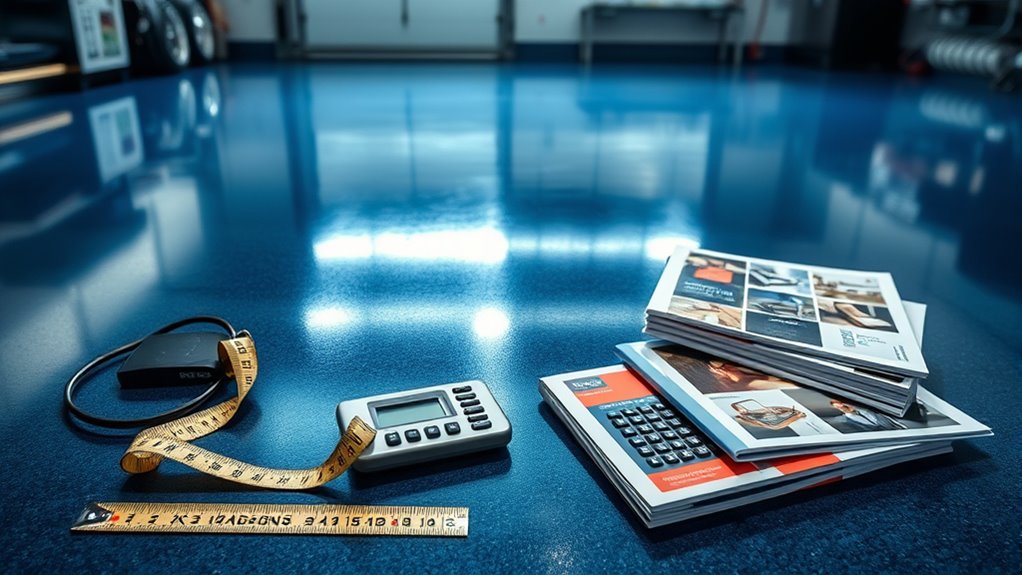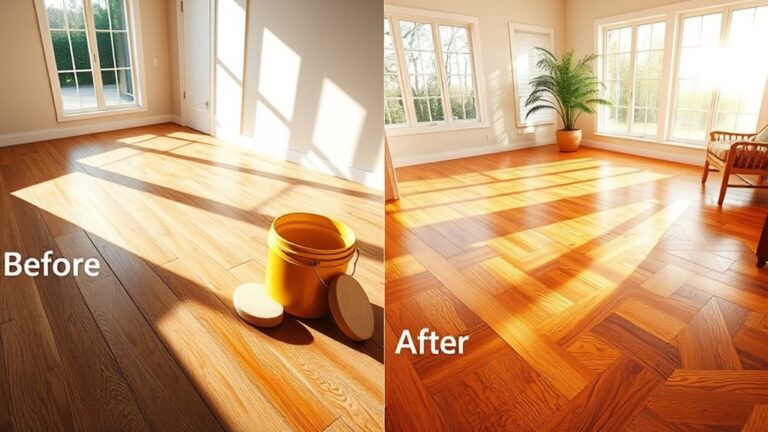You’ll want to contemplate several factors to understand epoxy floor costs: the type of epoxy—solid, metallic, or quartz-filled—which affects both material and labor prices; the floor’s current condition, since repairs and prep work add expenses; and any extra features like anti-slip additives or decorative flakes. Labor complexity and floor size also influence your total cost. Maintenance and repairs impact long-term value, so knowing these details will help you make smarter, budget-conscious choices. More nuances are worth exploring to get the full picture.
Factors Influencing Epoxy Flooring Costs

While epoxy flooring might seem straightforward, several critical factors influence its overall cost, which you’ll want to take into account before making a decision. First, epoxy color options greatly affect pricing; custom or multi-tone finishes typically cost more than standard solid colors due to the materials and labor involved. Next, installation techniques vary in complexity—basic roll-on applications are less expensive, while decorative techniques like metallic or flake systems require specialized skills and additional preparation, driving costs higher. Surface condition also matters; damaged or uneven floors demand extra repair and prep work, impacting your budget. Considering these precise elements guarantees you maintain control over your project’s scope and expenses, granting you the freedom to choose a solution that aligns with both your aesthetic goals and financial plans.
Types of Epoxy Flooring and Their Price Differences
Because epoxy flooring comes in several distinct types, understanding their specific characteristics and associated costs is essential for making an informed choice. You’ll encounter solid epoxy, metallic epoxy, and quartz-filled epoxy, each varying in durability and aesthetic appeal. Solid epoxy offers a uniform finish with extensive epoxy color options, making it ideal for simple, cost-effective applications. Metallic epoxy provides a unique, shimmering appearance but typically demands advanced installation techniques, increasing overall expense. Quartz-filled epoxy integrates quartz granules for enhanced texture and slip resistance, often used in high-traffic areas and priced accordingly. Your selection impacts not only the material cost but also the complexity of installation techniques required, influencing labor intensity and time. By aligning epoxy type with your functional needs and budget, you maintain both freedom and precision in your flooring choice.
Cost Breakdown: Materials, Labor, and Preparation

Three primary factors contribute to the overall cost of epoxy flooring: materials, labor, and surface preparation. The choice of epoxy floor types impacts material expenses—higher-grade resins and decorative flakes increase costs. Labor varies with installation techniques; complex patterns or multi-layer applications demand skilled professionals, raising fees. Surface preparation involves cleaning, repairing cracks, and moisture testing, essential for durability but adding to your initial outlay. Consider these cost components:
- Epoxy resin quality and additives
- Skilled labor for precise installation techniques
- Floor surface assessment and repairs
- Time-intensive prep work like grinding or moisture mitigation
Understanding these elements helps you control expenses without compromising freedom in design or performance. Your investment guarantees a long-lasting floor tailored to your needs and style preferences.
How Floor Size Affects Your Total Expense
When calculating your total expense, you’ll find that the cost per square foot is a key factor in pricing epoxy floors. Larger floor areas often qualify for discounts, reducing the overall rate as the size increases. Understanding how these variables interact helps you budget more accurately for your project.
Cost Per Square Foot
Understanding the cost per square foot is essential to accurately estimating your total expense for epoxy flooring. This metric provides pricing transparency, allowing you to compare installation techniques and materials effectively. The cost per square foot varies based on:
- Quality and type of epoxy used
- Surface preparation requirements
- Complexity of installation techniques
- Geographic location and labor rates
Larger Areas Discount
Although the cost per square foot provides a baseline, your total expense for epoxy flooring often decreases as the floor size increases, thanks to volume discounts and reduced labor intensity per unit area. When working with larger spaces, contractors typically offer bulk pricing, lowering the material cost per square foot. This happens because buying epoxy in larger quantities reduces packaging waste and shipping costs. Additionally, labor becomes more efficient since setup and cleanup times don’t scale linearly with floor size. For your project budgeting, this means you can expect a more favorable rate on bigger projects, allowing you to allocate funds elsewhere or upgrade materials. Understanding how floor size directly influences total cost empowers you to make smarter financial decisions when planning your epoxy flooring installation.
Additional Features That Can Increase Price

Since epoxy flooring offers a range of customizable options, certain additional features can considerably affect the overall cost. You’ll notice that design aesthetics and color choices play a significant role in pricing—complex patterns or multiple hues require more labor and materials. Beyond that, other enhancements can add to the expense, such as:
- Metallic pigments for a shimmering, depth-rich finish
- Anti-slip additives to improve safety, especially in wet areas
- Decorative flakes or quartz chips embedded for texture and style
- UV-resistant coatings that protect color integrity over time
Each feature demands specialized materials or application techniques, increasing installation time and cost. When you prioritize these options, you’re investing in a personalized floor that reflects your taste and functional needs, offering freedom to create a unique space without compromise.
Comparing Epoxy Flooring to Other Flooring Options
When choosing a flooring material, you’ll want to weigh how epoxy compares to alternatives like hardwood, tile, or vinyl regarding durability, cost, maintenance, and aesthetics. Epoxy benefits include exceptional resistance to wear, chemicals, and moisture, making it ideal for high-traffic or industrial spaces. Compared to hardwood, epoxy is more affordable and requires less upkeep, while offering a sleek, modern look that differs from traditional flooring aesthetics. Unlike tile, epoxy creates a seamless surface, reducing dirt accumulation and simplifying cleaning. Vinyl may be cheaper upfront but lacks epoxy’s longevity and toughness. If freedom in design and durability matters, epoxy flooring stands out by combining functional strength with customizable finishes, letting you tailor flooring aesthetics without sacrificing performance or budget.
Tips for Saving Money on Epoxy Floor Installation
If you want to reduce the overall expense of installing epoxy flooring, careful planning and preparation are essential. You can explore budget friendly options and even consider DIY installation to maximize savings. Here are some precise tips to help you cut costs without compromising quality:
- Choose epoxy kits designed for DIY use; they come with clear instructions and all necessary materials.
- Prepare your floor thoroughly yourself by cleaning and repairing cracks to avoid hiring professionals.
- Purchase epoxy during sales or from wholesalers to get better prices.
- Limit decorative additives or complex patterns, which increase labor and material costs.
Expected Lifespan and Maintenance Costs of Epoxy Floors
You can expect epoxy floors to last anywhere from 10 to 20 years, depending on the level of wear and maintenance. Routine cleaning is straightforward but essential to prevent surface damage and maintain appearance. However, occasional repairs may be necessary, so factoring in upkeep costs is important for an accurate long-term budget.
Durability and Longevity
Although epoxy floors are renowned for their toughness, understanding their expected lifespan and maintenance costs is crucial before committing to installation. You can expect epoxy floors to last 10-20 years, depending on usage and maintenance. Their exceptional heat resistance and chemical resistance make them ideal for industrial and residential settings alike. To maximize durability, consider these factors:
- Proper surface preparation guarantees strong adhesion and longevity.
- High-quality epoxy formulations enhance resistance to wear and tear.
- Heavy foot or machinery traffic may shorten lifespan without adequate protection.
- Prompt repair of chips or cracks prevents further degradation.
Routine Cleaning Requirements
Since routine cleaning plays a pivotal role in preserving the integrity of epoxy floors, understanding the specific maintenance tasks and their frequency is essential. You’ll want to commit to routine maintenance that prevents surface wear and buildup, ensuring your floor lasts its full expected lifespan without costly interventions. Cleaning frequency varies by usage intensity but generally involves daily dust mopping and weekly wet cleaning with non-abrasive solutions.
| Task | Recommended Cleaning Frequency | Purpose |
|---|---|---|
| Dust Mopping | Daily | Removes abrasive particles |
| Wet Cleaning | Weekly | Eliminates stains and grime |
| Deep Cleaning | Monthly | Restores surface luster |
This schedule balances effectiveness with effort, granting you freedom from premature floor degradation while optimizing upkeep costs.
Repair and Upkeep Expenses
Maintaining the routine cleaning schedule outlined earlier helps reduce the frequency and cost of repairs, but even well-kept epoxy floors will eventually require upkeep. The expected lifespan of epoxy floors typically ranges from 5 to 15 years, depending on use and care. Staying on top of maintenance schedules is essential to maximize durability and minimize expenses. Common repair techniques involve:
- Filling chips and cracks with epoxy putty to prevent further damage
- Sanding and recoating worn areas to restore surface integrity
- Addressing discoloration caused by UV exposure or chemicals
- Reapplying topcoat layers periodically to maintain slip resistance




